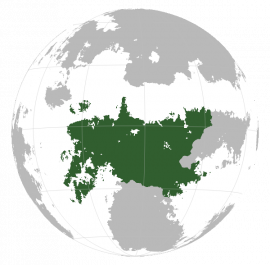Ekuosia
 | |
| Population | 850 million |
|---|---|
| Demonym | Ekuosian |
| Countries | |
| Languages | List of languages |
| Time zones | SCT+0 to SCT+6 |
| Largest cities | See list |
Ekuosia is a region of Northern Baredina stretching from the Taanttu and Armizziya seas in the west, along most of the northern shoreline of Baredina, and to Nevira and the Saru Sea in the east. The region is named after the massive Ekuos River, which is the longest river on Sahar and one of the earliest centers of civilization. With a population of more than 850 million people, Ekuosia is the most populous region of Sahar. It is often subdivided into Upper Ekuosia and Lower Ekuosia, the latter formed of Tabiqa and countries to its east. The Argeyaz Peninsulae, including the southern Algazi Union, are also sometimes considered a third subdivision.
The division exact division between Ekuosia and Puzimm in the northeast of Baredina is unclear and defined by a mix of cultural, historical, ethnic and geological reasons. Ebo Nganagam is sometimes considered part of Ekuosia and sometimes part of Puzimm, or to be split between the two regions.
Etymology
The region is named after the Ekuos River, the longest river on Sahar, which passes through a large number of the region's constituent nations. The river has had a massive impact on the history of the region overall. The river in turn gets its name from the Ekuostian word ekuo or something which probably just means 'river' too hey Ridley fix this up eh.
History
Prehistory
Ekuosia is host to the area most archaeologists and paleontologists agree was the most likely point of speciation for Homo sapiens roughly 200,000 years ago. The specific area encompasses a relatively small zone around the large lakes shared by Barradiwa, Tabiqa, and Ebo Nganagam. From this point, behaviorally modern humans gradually migrated in all directions, eventually spreading to Miraria, Alpa, Nagu, and lastly Boroso, with human migration to Ystel and Atsiq occurring far more recently due to these continents' isolation from Baredina and Miraria, respectively. These migrations spanned several tens of thousands of years, and are generally believed to have occurred in waves separated in time by thousands of years.
As a result of Ekuosia's proximity to humanity's point of speciation, it is home to a wide variety of cultures and languages, with the most variance being present in Ebo Nganagam. The cultural diversity was historically even greater than it is today, with the earliest records of the region 5,000 years ago noting several hundred distinct tribes and cultures in the region of Halaria alone. A handful of these cultures survive to the modern day, many of which expanded to encompass the majority of the region's population.
First Civilizations
In addition to the likely site of human evolution, Ekuosia is also home to one of the earliest civilizations in recorded history: Ancient Halaria, which was located in a small region of what is now eastern Azerin. This civilization was the origin of many early technological advances, notably writing, and the civilization's proximity to the longest river on the planet provided a perfect vessel for the gradual spread of ideas and technology that would facilitate the growth of other early civilizations on Sahar, and especially Baredina.
Little is known of the exact cause of the fall of Halaria, but the general consensus is that some sort of takeover (whether hostile or gradual) by the Letsic people displaced the ancient Halarians and led to a decline of local realms, resulting in the Letsic migrations and the rise of tribal confederations on the outskirts of the many city states holding the region together. The majority of the 3rd millennium BCE was characterized by frequent back-and-forth between agrarian tribal societies and urban city-states controlled by merchants and traders.
Later on in the 3rd millennium BCE, settlements such as Palace City grew large enough to eventually compete with other city-states found along the Ekuos-Khuda confluence. Historians studying this era of history frequently refer to the area around Stalo as "North Halaria" and the area around Palace City as "South Halaria" due to the similarities in the languages people in both areas spoke. The gradual increase in literacy rates and rise of ancient literature led to a dramatic shift from oral tradition to written records, with numerous legal systems, religious customs, and mythologies being codified and shared among the scholarly castes of each region.
Classical Era
Most of the 2nd millennium BCE was characterized by more migrations and tribal conflicts, although the rise of dynastic rule and the advent of currency led to gradual stabilization of the region. This millennium also saw the rise of other ancient civilizations, such as the Adzamic and Lonish societies, before being capped off by the monolithic rise of Iovism in Halaria as a standard for which other Halarian belief systems would adapt to. The rise of the Halarian continuum led to the rise of more significant city-states, many of which were built for religious purposes rather than economic or defense. One example of this is Madrana, which even grew to be almost as significant as Stalo at the time due to its status as being where the Council of Madrana would meet.
The Iovist faith spread very slowly at first, initially only catching on in North Halaria before it grew to be a vessel for rapid economic and political development in both North and South Halaria by 500 BCE. The latter half of the 1st millennium BCE was characterized by the rise of numerous classical kingdoms, namely in Western Ekuosia and especially within the Letsatian Basin and the Tabiq-Ekuos confluence. The tail end of the millennium saw the rise of the Letsatian and Adzamasi Empires, which would go on to profoundly shape the region's history over the following centuries.
Post-Classical Era
Gunpowder was invented in ancient Nevira and it fueled the sudden explosion of the Neviran Empire across most of Ekuosia.
Early Modern Era
Saruan Empire in eastern Ekuosia, Puzimm, and other areas connected on the Saru Sea.
Modern Era
Geography
Climate
While Ekuosia is predominantly hot as a result of its equatorial location, it nonetheless has a highly varied climate. The northern coast receives heavy rainfall, and was once home to vast tropical rainforests; much of this has been lost to deforestation over several millenia of human habitation in the region, but areas of rainforest still be found throughout northern Ekuosia, particularly in Ebo Nganagam. The climate becomes drier in the south, with tropical regions giving way to Mediterranean climates on the western coast and the Great Baredinian Desert in the interior.
Demographics
Cities
Below is a list of largest cities in Ekuosia:
Largest cities in Ekuosia
Source? | |||||||||
|---|---|---|---|---|---|---|---|---|---|
| Rank | Country | Pop. | Rank | Country | Pop. | ||||
 Sonegio |
1 | Sonegio | Barradiwa | 14,638,315 | 11 | Komy | Rosland | 5,476,000 |  Panemi |
| 2 | Gshons | Letzia | 12,183,400 | 12 | Mırad | Algazi Union | 5,032,740 | ||
| 3 | Panemi | Veridia | 8,514,700 | 13 | Kostenbad | Barradiwa | 4,361,447 | ||
| 4 | Eyadhan | Algazi Union | 7,602,380 | 14 | Vorrud | Letzia | 4,234,163 | ||
| 5 | Mehyaran | Tabiqa | 7,161,320 | 15 | Rydkes | Barradiwa | 4,196,782 | ||
| 6 | Yazurum | Algazi Union | 6,872,420 | 16 | Glorp | Cerman | 3,782,866 | ||
| 7 | Yisma | Nevira | 6,124,097 | 17 | Hafsigh | Algazi Union | 3,762,280 | ||
| 8 | Kúri | Cerman | 6,054,560 | 18 | Nunkes | Barradiwa | 3,523,231 | ||
| 9 | Stalo | Azerin | 5,914,700 | 19 | Manan | Kedros | 3,015,933 | ||
| 10 | Aramos | Povan Union | 5,656,931 | 20 | Gemet | Hemesh | 3,001,764 | ||
Culture
Notes
- ↑ Cerman has territory in both Terminian Isles and Ekuosia. See Utol.